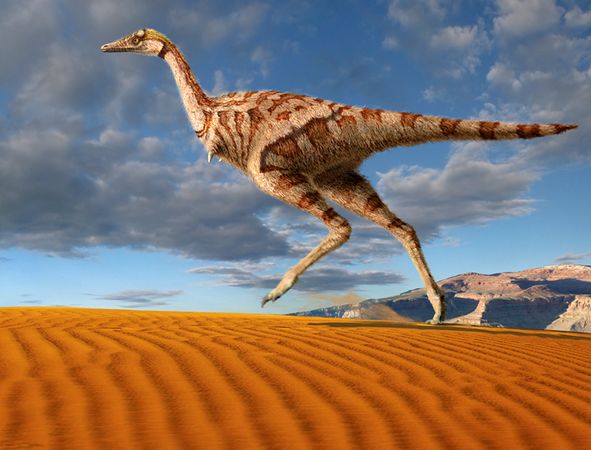| Location: Home > News > Events |
| National Geographic: First One-Fingered Dinosaur FoundNational Geographic: First One-Fingered Dinosaur Found—Dug for Bugs? |
|
Linhenykus likely used long digit to probe termite mounds.

An artist's rendering of the one-fingered, short-armed new dinosaur Linhenykus monodactylus. Illustration courtesy Julius T. CsotonyiJohn Roach Published January 24, 2011 Dig this: A parrot-size dinosaur has been discovered with just one enlarged "digging" finger on each hand, scientists announced today. Unearthed in northeastern China, Linhenykus monodactylus is a member of the theropod dinosaurs, the group of two-legged carnivores that includes Tyrannosaurus rex and Velociraptor. Most theropods had three fingers on each hand. But Linhenykus belongs to a family known as the alvarezsauroids: small, long-legged dinosaurs that had one big finger alongside two barely functional nub fingers. "Some researchers speculate that these dinosaurs used their hands to dig [up] termite nests," said study leader Xu Xing of the Institute of Vertebrate Paleontology and Paleoanthropology in Beijing. This was probably the case for Linhenykus as well, he said. (Related: "Digging Dinosaur Discovered Inside Fossil Den.") Linhenykus' hand does have a leftover bone for a second finger, but the nub of a digit wouldn't have worked at all, Xu added. That makes Linhenykus the only known one-fingered dinosaur, he said. New Dinosaur Adds to Tale of Hand Evolution The new dinosaur was discovered in a fossil-rich rock formation that dates to the late Cretaceous period, between 84 and 75 million years ago. The site is near the Inner Mongolian town of Linhe (map), which helped inspire the dinosaur's name. (Related: "New Dinosaur—'Exquisite' Raptor Found.") Alvarezsauroid fossils have been found in North and South America as well as Asia, dating from the late Jurassic to the late Cretaceous. Finding an alvarezsauroid in Asia dated to the late Cretaceous adds to the story of this group's dispersal around the world, Xu said. "[They] probably originated in Asia, then dispersed from Asia to [the ancient supercontinent] Gondwana, and then back to Asia, and finally from Asia to North America," he said. The other dinosaurs in this group probably didn't make much use of their functional nub fingers, the study authors note. But the extra fingers would have been biologically inexpensive to maintain, so they didn't totally disappear. By contrast, Linhenykus had no working vestigial nubs, and its one long finger wasn't as specialized for digging as the digits of other alvarezsauroids. This demonstrates that hand evolution in this group "did not follow a simple linear trend," the study authors write. The new, one-fingered dinosaur is described online today in the journal Proceedings of the National Academy of Sciences. |